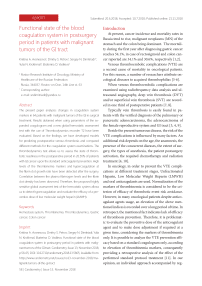Functional state of the blood coagulation system in postsurgery period in patients with malignant tumors of the GI tract
Автор: Katelnitskaya Oksana V., Kit Oleg I., Guskova Nailya K., Avanesova Kristina А., Katelnitsky Igor I., Petrov Dmitry S., Shaposhnikov Aleksandr V., Dimitriadi Sergey N., Chubaryan Anna V., Burtsev Dmitry V., Krokhmal Yulia N., Vasilieva Ekaterina О.
Журнал: Cardiometry @cardiometry
Рубрика: Report
Статья в выпуске: 13, 2018 года.
Бесплатный доступ
The present paper analyzes changes in coagulation system markers in 64 patients with malignant tumors of the GI in surgical treatment. Results obtained when using parameters of the expanded coagulogram and a new global hemostatic assessment test with the use of Thrombodynamics recorder T2 have been evaluated. Based on the findings, we have developed models for predicting postoperative venous thrombosis and compared different methods for the coagulation system examinations. The thrombodynamics test allows us to assess the state of thrombotic readiness in the postoperative period in 26.56% of patients with GI cancer upon the standard anticoagulant prevention. High levels of the thrombinemia markers and hypercoagulation at the fibrin clot growth rate have been detected after the surgery. Correlation between the plasma fibrinogen levels and the fibrin clot density has been observed. Therefore, the proposed highly sensitive global assessment test of the hemostatic system allows us to detect hypercoagulation and evaluate the efficacy of a preventive dose of low molecular weight heparin (LMWH)
Hemostasis system, thrombinemia, thrombodynamics, gastric cancer, colon cancer
Короткий адрес: https://sciup.org/148308854
ID: 148308854 | DOI: 10.12710/cardiometry.2018.13.5865
Список литературы Functional state of the blood coagulation system in postsurgery period in patients with malignant tumors of the GI tract
- Kaprin AD, Starinskiy VV, Petrova GV. Malignant neoplasms in Russia in 2015 (morbidity and mortality). Мoscow, 2017. 250 p.
- Arkhipova OE, Chernogubova EA, Likhtanskaya NV, et al. Analysis of occurrence of oncological diseases in the Rostov region. Spatial-time statistic. Fundamental'nye issledovaniya. 2013;7-3:504-10.
- Khorana AA, Francis CW, Culakova E, et al. Thromboembolism is a leading cause of death in cancer patients receiving out -patient chemotherapy. J Thromb Haemost. 2007;5(3):632-4.
- Makatsariya AD. Thrombohemorrhagic complications in obstetric-gynecological practice: guidance for physicians. Мoscow, 2011. 1056 p.
- Khorana AA. Venous Thromboembolism Prevention in Cancer Outpatients. J. Natl. Compr. Canc. Netw. 2013;11(11):1431-8.
- Monreal M, Trujillo-Santos J. Screening for occult cancer in patients with acute venous thromboembolism. Curr. Opin. Pulm. Med. 2007;13:368-71.
- Rasmussen MS. Prolonged thromboprophylaxis with low molecular weight heparin after major abdominal surgery. Curr. Opin. Pulm. Med. 2007;13:389-92
- Lee Agnes YY. Treatment of venous thromboembolism in cancer patients. Best Practice & Research Clinical Hematology. 2009;22:93-101.
- Kit OI, Frantsiyants EM, Kozlova LS, et al. Free and bound plasmin in tum. and adjacent tiss. of men and women with esophag.l squamous cell carcinoma. Sovremennye problemy nauki i obrazovaniya. 2017, No. 2.
- Ay C, Vormittag R, Dunkler D, et al. D-dimer and prothrombin fragment 1 2 predict venous thromboembolism in patients with cancer: results from the Vienna cancer and thrombosis study. J Clin Oncolоgy. 2009;27(25):4124-9.
- Momot AP, Tsyvkina LP, Taranenko IA, et al. Modern methods of recognition of thrombotic readiness. Barnaul, 2011. 138 p.
- Russian clinical guidelines for the diagnosis, treatment and prevention of venous thromboembolic complications (VTEC). Flebologiya. 2015;9(4):2-52.


